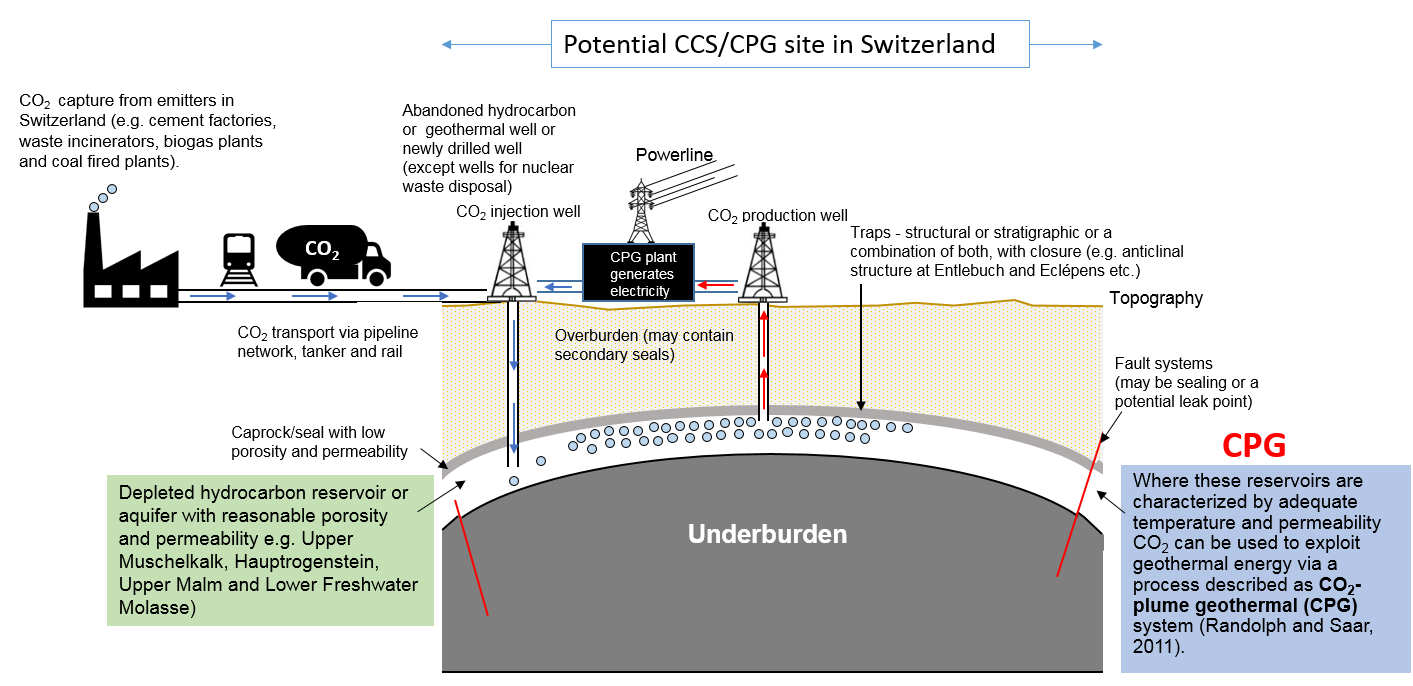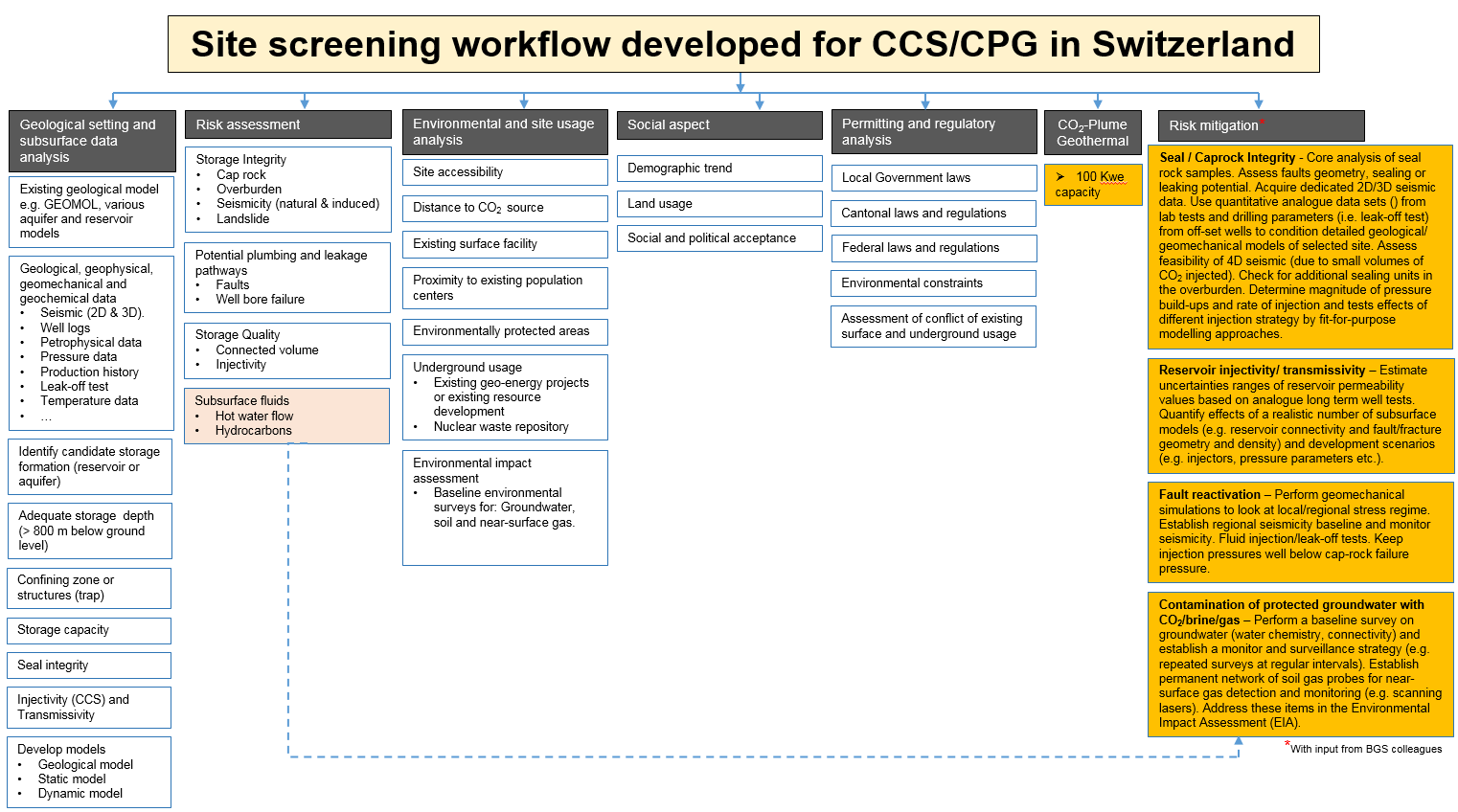Site selection for geological storage of CO2 in Switzerland

January 2021 - by Dr. Ovie Emmanuel Eruteya, Prof. Dr. Andrea Moscariello
Geological sequestration of carbon dioxide (CO2) is believed to be an effective measure to combat the anthropologically induced climate change and increase in atmospheric temperature. How can Switzerland play a role in this long-term effort? What is the real potential of the Swiss subsurface to permanently store CO2 or employ this gas in electricity production? The Geo-Energy, Reservoir Geology & Basin Analysis Group from the University of Geneva is working on this topic within the SCCER-SoE in the context of the ELEGANCY project funded by the European Commission.
Carbon capture and storage operations (CCS), also known as sequestration, is now a widespread practice and a viable path for reducing atmospheric carbon dioxide (CO2) concentrations with implication on climate change and global warming. Successful sequestration of CO2 in deep formations (called sinks) 800 metres or more below ground provides a permanent storage solution for anthropogenic CO2 emitted from large industrial sources (e.g. cement factories, waste incinerators or coal-fired plants, see figure 1). CO2 sequestration is vital for ensuring environmental sustainability by cutting down on greenhouse gas emissions. Potential subsurface storage targets for CO2 sequestration encompass depleted hydrocarbon reservoirs, aquifers (saline formations), un-mineable coal seams, organic-rich shales and basaltic formations.
In Switzerland, despite the promising theoretical storage capacity potential of 2670 million tons of CO2 for the Swiss Molasse Basin (Chevalier et al., 2010), the possibility for suitable large-scale underground storage for CO2 still needs to be assessed accurately. A major challenge is an accurate regional screening leading to the identification of candidate sites suitable for pilot-scale or commercial-scale storage of CO2 in Switzerland. Especially, the scarcity or lack of available or reliable geological data hamper this challenge even more. Another challenging issue is the vertical and lateral subsurface geological complexity and heterogeneity. Despite those challenges, the scientists will carry out a site screening activity under the context of the ELEGANCY project to identify potential areas suitable for underground CO2 storage in Switzerland.
How to find suitable sites
The goal of this study is to identify candidate sites in Switzerland that fulfil the necessary conditions for the safe injection and long-term storage security of CO2 in accordance to stipulated global best practices (e.g. Aarnes et al., 2019; NETL, 2017). This involves quantifying the important properties necessary for CO2 injection and storage sites. Once the quantifications are done, the scientists will model the CO2 plume in the targeted storage formation and assess the risk and associated uncertainties. To achieve this, they will examine existing subsurface geological data. More specifically, they will search for subsurface structures with regional 2D-seismic data. Additionally, they will examine a large set of non-geological and cultural data (i.e. proximity to CO2 point sources such as incinerators and cement factories, available volumes of CO2, conflicts of subsurface use, etc.).
Workflow proposed for screening candidate sites in Switzerland for CO2 storage
The scientists proposed a screening workflow considering the subsurface geological framework of Switzerland, its underground usage in terms of existing, on-going and future geo-energy, nuclear waste repository projects, the subsurface manifestation of fluids and the envisage regulatory framework. The workflow they developed in this study (see figure 2) should serve as a guideline and would be ideally applicable for any promising geological CO2 storage site in Switzerland.
Carbon capture and potential electricity generation in Switzerland
Potential sites currently under investigation in Switzerland include several locations where the underground geology is known thanks to the existence of old deep wells previously drilled for hydrocarbon explorations (see figure 2). Those previous findings of hydrocarbon in the Swiss subsurface might be an interesting indication of suitable subsurface characteristics such as reservoir occurrence and transmissivity. However, further investigations need to be carried out to accurately estimate connectivity, storage capacity and related risks (i.e. induced seismicity) associated with CO2 injection.
In general, regions with depleted natural gas reservoirs are potential sites and suitable for CCS based on the availability of storage capacity, proven caprock/trap, solid knowledge of the storage reservoir and existing surface infrastructure. In addition, reservoirs at depth below 3000 metres underground are associated with geothermal temperatures above 100° Celsius. This may offer the possibility to generate electricity by using CO2-Plume-Geothermal (CPG) systems where the CO2 injected in the reservoir is then employed at the surface to operate the turbine and generate electricity (Randolph and Saar, 2011, see figure 2).
Outlook
The site screening and selection studies are currently on-going in the context of the ELEGANCY project to identify geological structures capable of trapping CO2 as a pilot or commercial scale CCS operation. The final workflow will include robust conceptual geological models for the identified sites, which will lead to the building of 3D static geo-cellular models. The scientists will then model the identified aquifer or reservoir intervals with relevant porosity and permeability values. Given the broad range of subsurface uncertainties and reservoir parameter variability, they will perform probabilistic based volumetric assessments of storage capacity. Ultimately, the scientists will use the 3D static models as input for dynamic simulation to understand the fate of the CO2 plume and as a basis for geo-mechanical modelling to predict induced seismicity associated with injectivity tests.
References
Aarnes, J.E., et al., 2009. Energy Procedia, 1(1), pp.1735-1742.
Chevalier, G., et al., 2010. Swiss Journal of Geosciences. 103(3), pp. 427–455.
NETL, 2017. https://www.netl.doe.gov/sites/default/files/2018-10/BPM-SiteScreening.pdf.
Randolph, J.B. and Saar, M.O., 2011. Combining geothermal energy capture with geologic carbon dioxide sequestration. Geophysical Research Letters, 38(10).

